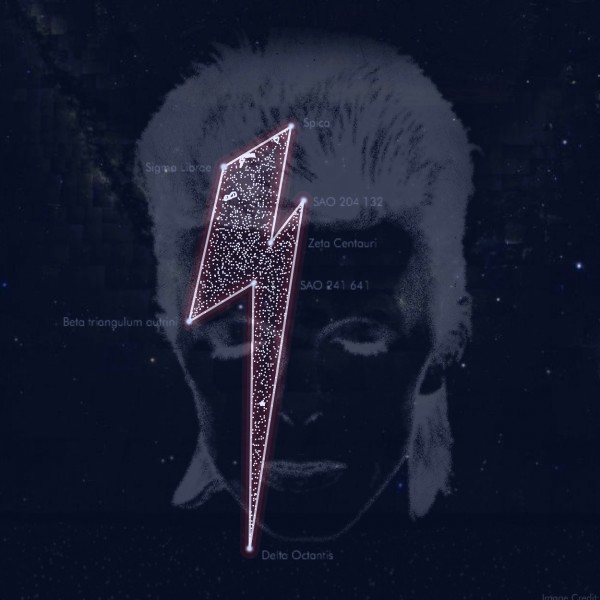

By Guy Ottewell.
Rock star David Bowie died, and according to the Guardian he was “inspired by the universe” (who isn’t?) and so a new constellation has been “registered” for him, “in the shape of a lightning bolt” and “near Mars.”
This story was perhaps picked up from a slightly less garbled version in Rolling Stone magazine. What happened was that Studio Brussels (a Belgian radio station aimed mainly at a youth audience) asked MIRA Public Observatory (at Grimbergen, north of Brussels) “to give Bowie a unique place in the galaxy.” The astronomers “chose seven stars – Sigma Librae, Spica, Alpha Virginis, Zeta Centauri, SAA 204 132, and the Beta Sigma Octantis Trianguli Australis – in the vicinity of Mars. The constellation is a copy of the iconic Bowie lightning and was recorded at the exact time of his death.”
Spica and Alpha Virginis are the same star, and something has been dropped before “Trianguli Australis,” so the “seven” stars have become five. Unexplained are the relevance of Mars and what is meant by “recorded at the exact time of his death,” since that occurred on January 10.
Those garblings are no doubt not the fault of the astronomers. What they obligingly did was find seven stars between which they could draw long lines to make the “shape of a lightning bolt.”
The stars they picked range from one of the sky’s brightest (Spica) to one among thousands in a catalog for specialists, thousands of times too faint for the naked eye (SAA 204 132). They are soaced over nearly a quarter of the sky, from near the equator (Virgo and Libra) to near the sky’s south pole (Octans).
“In the vicinity of Mars” means that Mars, for the current week or two, is moving from Virgo into Libra.

Mars and its vicinity do not, this month, appear in the sky until an hour or more after midnight. If Bowie fans wish to see the main part of this “constellation” they will have to go outside in the after-midnight hours, or, to see the other tip of it, live in the southern hemisphere and have access to a major telescope.
Fine. It’s a flight of fancy. Those who know something about the sky don’t need to sigh with annoyance unless they hear someone say “Did you know that some stars have been named for David Bowie?” or at the misuse of the word “constellation.” There are 88 constellations, dividing the whole sky between them, and you can’t add to the number. The astronomers of MIRA Public Observatory certainly know this, and we don’t know whether they tried to insist on the correct term, which is “asterism,” and were overruled because everyone’s heard of constellations and no one’s heard of asterisms. What are they, fits caused by star-struckness?
An asterism is any grouping of stars anyone likes to make. The Big Dipper is an asterism because it is only part of constellation Ursa Major; the Summer Triangle, the Winter Hexagon, and the False Cross are asterisms because they connect stars in more than one constellation; there is any number of asterisms that observers have popularized, such as the Coathanger, the Teapot and Teaspoon of Sagittarius, the Urn or Water Jar of Aquarius, the Three Leaps of the Gazelle, the Leaping Minnow.
So there’s no objection to adding the David Bowie Lightning Bolt asterism. Except that you may have to shorten the name if it’s to have more than a week or two of life (the Bowie Bolt?).
And that, whereas other vast asterisms can be seen by anybody, and small ones can be seen in binoculars or telescope, there’s no hope of seeing this one at all.

Confession, which Tilly wishes I wouldn’t make, but which I feel to be in the spirit of this less than conventional blog. She found this news item, as others, by surveying online articles. It’s a generous use of her mind, which would not ordinarily be directed toward astrophysics. She is easing me into the use of Twitter. “Come and look at this,” and she reads to me an article about Albert Einstein or David Bowie. From which I have been learning much that I otherwise wouldn’t. You might consider following me @GuyOttewell, and thus be occasionally alerted to other interesting developments between blogs.
Follow Guy Ottewell on Twitter: @guyottewell
Article written and published originally by astronomer, artist and poet Guy Ottewell, whose beloved Astronomical Calendar is now in its 43rd and final year. Visit Guy’s website Universal Workshop or his blog. Used with permission.
Bottom line: Has a constellation been named for late rock musician David Bowie? Not officially.











